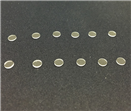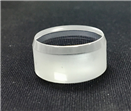

Time:2025-05-09
Sapphire high-strength glassThis single crystal material, formed by the crystallization of high-purity alumina at high temperatures, has demonstrated enormous potential and value in multiple high-tech and industrial fields due to its unique physical and chemical properties since its inception. Especially in precision optical instruments, sapphire high-strength glass has become an important material due to its optical transparency over a wide spectral range.
The optical transparency of sapphire high-strength glass refers to its ability to maintain high transparency over a wide spectral range (approximately 0.15 μ m to 5.5 μ m), which gives sapphire glass a unique advantage in optical applications. Sapphire glass exhibits high optical transparency from deep ultraviolet to mid infrared, particularly in the spectral range of 0.3 μ m to 5 μ m. This optical performance makes sapphire glass an ideal material for high-performance optical windows, lenses, and lenses, widely used in fields such as ultraviolet spectrometers, infrared detectors, and laser systems.
In precision optical instruments such as high-precision camera lenses, microscopes, telescopes, etc., there are high requirements for the optical performance of materials. The high transparency and low scattering properties of sapphire high-strength glass make it the preferred material for these high-precision optical devices. High transparency means that light can maintain a high transmittance when passing through materials, reducing light loss and improving the imaging quality and resolution of optical devices. Low scattering means that light is not easily scattered inside the material, and can maintain the directionality and coherence of light, which is crucial for the application of optical phenomena such as optical interference and diffraction.

In addition to excellent optical transparency, sapphire high-strength glass also possesses various other physical and chemical properties, making its application in precision optical instruments more extensive and in-depth.
Firstly, sapphire glass has a high hardness, close to that of diamonds, providing high wear resistance and scratch resistance. This characteristic enables sapphire glass to effectively resist external scratches and wear when used as a surface material for optical devices, extending the service life of optical devices. In watches, sapphire glass is often used as a mirror material to protect the watch from damage and provide a clear reading experience. Sapphire glass is also commonly used as a screen protector material in smartphones and smart wearable devices to resist scratches and impacts during daily use, improve device durability and display performance.
Secondly, the thermal expansion coefficient of sapphire glass is relatively low, which means that its size can remain stable under temperature changes. This characteristic makes it play an important role in precision optical instruments, as the accuracy and performance of optical devices are often affected by temperature changes. The low thermal expansion coefficient of sapphire glass enables it to maintain dimensional stability under temperature changes, ensuring that the accuracy and performance of optical devices are not affected. In addition, the high thermal conductivity of sapphire glass enables it to effectively dissipate heat in high-temperature environments, reduce thermal stress accumulation, and further improve the stability and reliability of optical devices.
Furthermore, sapphire glass also has excellent resistance to chemical corrosion. In the manufacturing and use of optical devices, various chemical substances such as acids, bases, salts, etc. are often encountered. If the material does not have sufficient resistance to chemical corrosion, it is susceptible to erosion and damage from these chemicals. Sapphire glass, due to its stable chemical properties, can resist the erosion of these chemicals well, ensuring the normal operation and long-term stability of optical devices in harsh environments.
In the application of precision optical instruments, sapphire high-strength glass also exhibits various other advantages. For example, its high transparency and low scattering make it an ideal choice for high-resolution optical systems; Its high hardness and wear resistance enable it to maintain high-quality image acquisition performance in harsh environments; Its low thermal expansion coefficient and high thermal conductivity enable it to maintain dimensional and structural stability in high-temperature environments; Its resistance to chemical corrosion enables it to function normally in various harsh chemical environments.
Sapphire high-strength glass has excellent optical transparency over a wide spectral range, making it a key material in precision optical instruments. Thanks to its high hardness, wear resistance, low thermal expansion coefficient, high thermal conductivity, chemical corrosion resistance, and other physical and chemical properties, sapphire glass has demonstrated enormous potential and value in various high-tech and industrial fields.






Tel
Mobile phone
Customer service
TOP